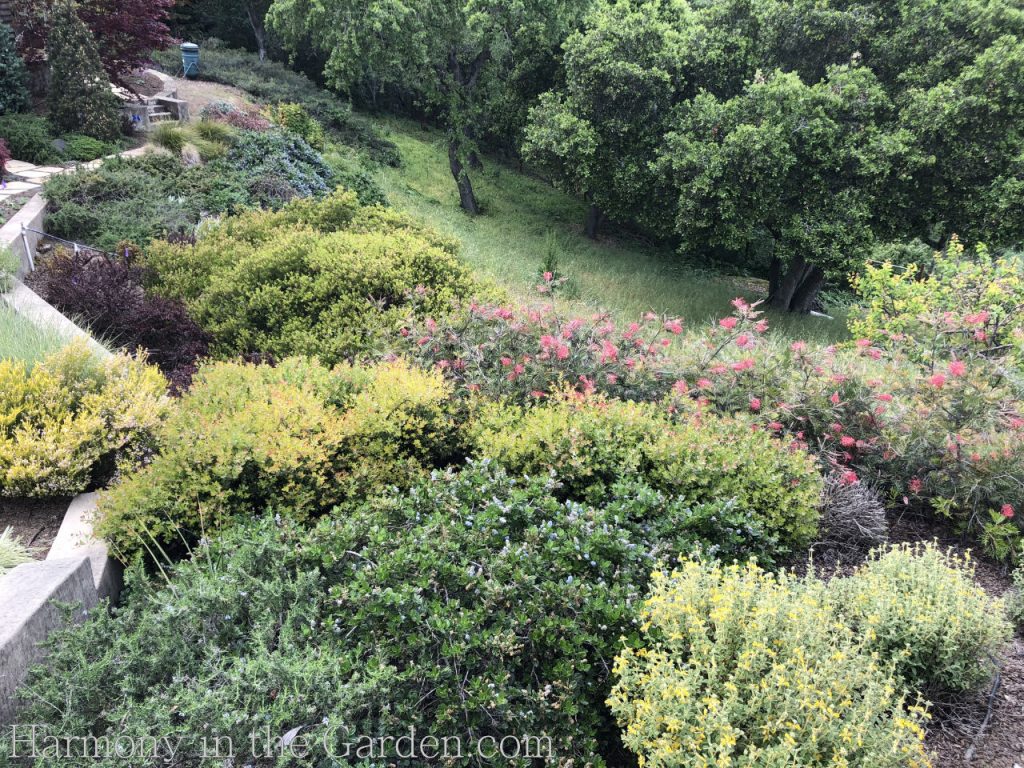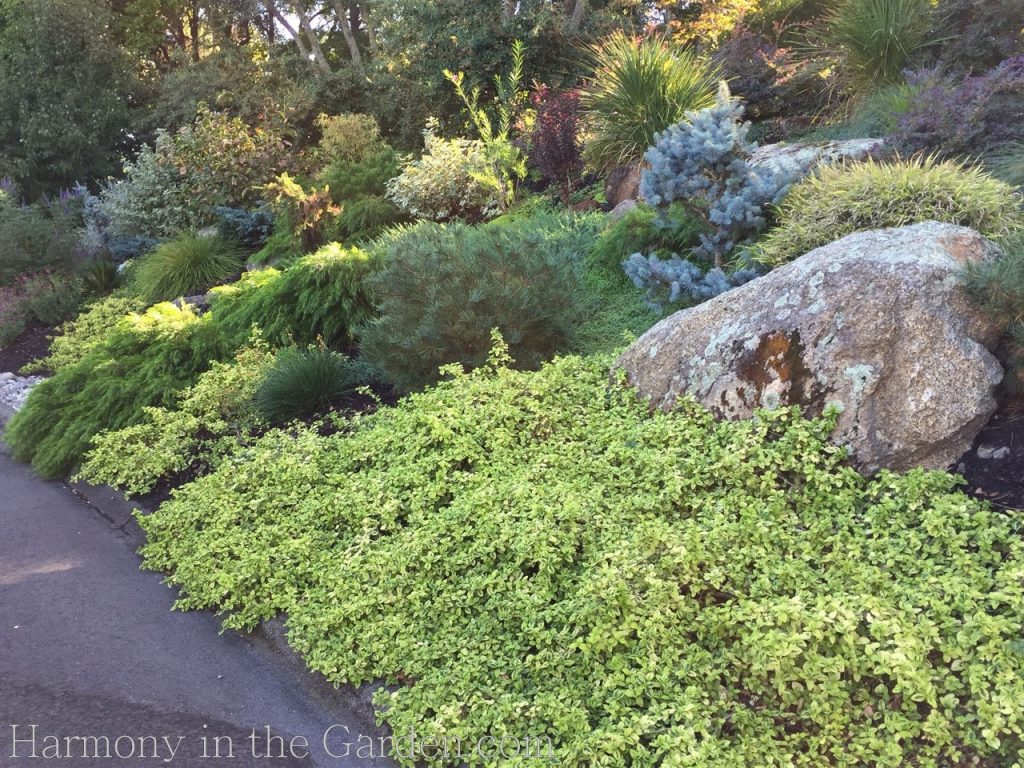
Gardening on steep slopes is problematic at best.
Ever try and plant, prune, or deadhead on a steep hill? NOT fun. I should know. I’ve spent the past 2 years working in my new garden , trying to tame a pretty slope that has caused me to shed a tear or two in frustration.
And you can imagine what it looks like after a pouring rain, right? A big, muddy mess at the bottom of the hill.
That’s where a tier or two in the garden can save the day.
Recently, I visited a few of my clients’ gardens and was thrilled at how beautiful those once-daunting steep slopes now looked. So, I thought I’d share with you some of the ways we successfully tackled these problems.
Careful Plant Selection

BEFORE
In this garden, my client had a long, steep slope that paralleled the neighboring fence-line.
For years, vinca was allowed to run rampant since it was the only thing that would thrive in this space with no maintenance.
However, it wasn’t really no maintenance since it had to be regularly reined in from invading the rest of the garden.
AFTER
To control the steep slope, we built a Connecticut Bluestone retaining wall.
The result were two tiers which were much easier to navigate, plant, and maintain (not to mention no more dirt sliding down the hill!)
Even though the two tiers provide a level surface on which to walk, it’s still essential to use low-maintenance plants.
After all, even though it’s easier to access, it’s still a pain. Trust me, no one wants to climb up there to prune or deadhead!


We also needed to keep these tiered spaces cohesive with the surrounding garden beds.
The solution was to repeat many shrubs that we had previously planted in other areas; including westringea ‘Smoky,’ grevillea ‘Scarlet Sprite,’ elaeagnus ‘Gilt Edge,’ lomandra ‘Breeze Mat,’ and structural phormium ‘Pink Stripe’ to name just a few.
All require very little maintenance, perhaps pruning once a year at most to keep random branches in check, while providing a tapestry of color, blending in with the existing garden.

The lower tiers are much easier to access and maintain, so this is where you’d want to include your favorite higher-maintenance perennials and deciduous shrubs.
Some of the favorites we used were Corsican hellebore, acanthus, tagetes lemmonii (Mexican Marigold), viburnum tomentosum ‘Summer Snowflake,’ and ‘Meerlo’ lavender.
Triangles

BEFORE
In this garden, my client had attempted to control the slope by creating tiers made of raised wood boxes.
The result was disjointed, sparsely planted, and overall less than ideal.
AFTER
We replaced the raised boxes with a series of low 2-foot retaining walls made of stacked Napa fieldstone.
When planting in tiers (whether it’s a gentle or steep slope), it’s important to remember continuity. By that, I mean tying the new space into the surrounding garden.
It’s not as easy as it sounds, as the tendency is to plant these long and linear spaces in ‘strips.’


This is the garden (above pic) right after we built the retaining walls and placed the plants.
To avoid creating a ‘planting in a straight line’ effect, one of the things I do is to create triangles within the different layers to link the tiers to one another.
For example, the top tier might have two lavenders, while the lower tier has one.

Here’s another example from a garden where we planted euphorbia wulfenii above and below the raised wall.
This not only helps blur the lines of the tiers but also causes the eye to travel up and down, versus back and forth.
Drifts

BEFORE
In this garden, my client had battled this slope for decades, but it was so difficult for him to plant and maintain that the gophers and weeds ultimately took over.
Which was such a shame, as it was an eyesore when standing on their deck.
AFTER
Our solution was to plant drifts of low-maintenance and low-water plants, spacing them close enough to crowd out any future weeds.
These plants also had to have robust root systems that grow deep to help hold the soil in place.
On an expansive and steep slope such as this, planting in drifts (or blocks) can create a visual ‘wow’ moment.

Planted along this long slope are drifts of manzanita (arctostaphylos ‘Howard McMinn’), westringea ‘Morning Light,’ eleagnus ‘Gilt Edge,’ lomandra ‘Breeze Mat,’ and grevillea ‘Coastal Gem’ at the bottom.


Other plants that do well on slopes are Golden St. John’s Wort (hypericum frondosum ‘Sunburst’) and many groundcovers, such as the ceanothus ‘Highlights’ below.
And don’t forget that some plants grow best when growing on a slope, such as our native Toyon. Just take a hike in the hills and you’ll see what I mean!



In this garden, the slope was much less severe and therefore didn’t require a retaining wall.
However, we still planted in large drifts to create that ‘wow factor,’ making sure to include shrubs with contrasting foliage colors of gray, green, and maroon.
Don’t forget the drapers!

To soften the harsh lines of a retaining wall, don’t forget to include plants that will gently drape over and down the wall.
Even if it’s only one-foot-high, I always like to include softeners such as succulents and westringea ‘Mundi.’

Anything with a soft shape will work, like this common oleander ‘Petite Salmon’.

Or this drought-tolerant zauschneria ‘Everett’s Choice.’
For more photos on this amazing garden’s front-yard transformation, click here.

Heck, even a kitty will do!
I hope these examples inspire you to go forth and tackle those slopes once and for all!
Do you have any favorites you use on your tiers, slopes, or retaining walls? If so, please share!






9 Comments
Thank you for this article. I’ve been trying to search for inspiration on how to design a slope, both visually and practically (soil erosion). My garden is similar to the one mentioned above with a terrace – from which the garden will mostly be seen from above. So many planting guides out there focus on what they look like from the bottom! I really liked your tips on planting in triangles. Despite I’ll be looking at native plants to where I am (central Italy) I also appreciated your choice of plants. Thank you for sharing your knowledge.
kind regards,
Hello Camilla. I’m so glad you enjoyed my post, thanks for such a kind comment. (Lucky you to live in Italy! I’ve been there three times and wow – I just LOVE it. Our climates are so similar, too!)
Rebecca, although I’m a big fan of your designs, what I love even more is how well you explain what you do, and why. It’s so easy to understand the planting design concepts when you draw on the photos this way. As an Aussie, I’m also surprised at how many Australian native cultivars you use – they obviously thrive in your climate and soils. I wish more Australian landscape designers valued our plants and used them as expertly as you do! Here they clip everything into spheres, rather than let them spread exuberantly like this…
Thank you so much, Catherine, for such a lovely comment. I really appreciate it. I absolutely LOVE Australian plants and am so happy to see them being used here more and more. I used to only be able to get one or two cultivars of grevillea or westringea, but over the past 15 years I’ve seen so many available now in mainstream nurseries. When looking at Australian websites I’ve noticed the sheared balls, too, and wonder why that’s so popular!? They’re such lovely plants in their natural state. Oh well – we have plenty of sheared balls here, too (just walk around my neighborhood and you’ll see beautiful loropetalum and coleonema shaped into the weirdest shapes, like clunky ottomans and off-kilter squares.)
I think that plants clipped into balls can be a good form contrast to our grassy type plants, like lomandra, kangaroo paw and dianella. Which the Kiwis also do with their clipped pittosporums next to NZ flax (phormium) and carex. But they’re way, way overused and, of course, such constant clipping means no flowers.
Have you visited Jo O’Connell’s Australian Native Plants nursery in Casitas Springs, Ca?
how lovely…happy gardening!
Thank you!
BEAUTIFUL and sensible, tantalizing, inspirational, and glorious.
You’ve created some of my favorite personal gardens. Gardens that most anyone can tackle and tend. I love your style and your do-ability. Is that a word?
Love,
S
Thank you, Sharon! ‘Do-ability’ – I love it! I never want to create a garden that a client can’t maintain, so I appreciate your perceptive-ness (is THAT a word?) xoxoxo